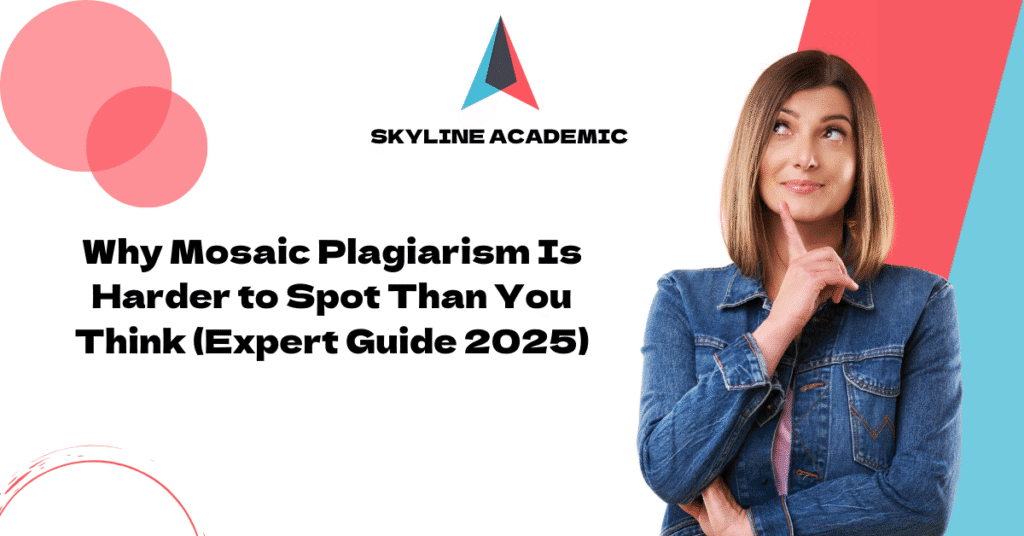Why Mosaic Plagiarism Is Harder to Spot Than You Think (Expert Guide 2025)
Mosaic plagiarism sneaks past detection systems more often than you might think. Writers borrow phrases without quotation marks or swap original words with synonyms that keep the same structure and meaning . Academic experts call this “patch writing,” and adding footnotes doesn’t make it right – it’s still academically dishonest and comes with penalties.
A revealing survey by Vassileva and Chankova shows that 44% of researchers at major scientific institutions don’t see unintentional plagiarism as a “crime” . The effects remain just as serious, whether done by accident or design. What’s the best way to keep your writing original? Weak writing skills often lead to accidental plagiarism . The most straightforward cases are deliberate ones – copying from classmates or buying papers online . This piece will walk you through spotting mosaic plagiarism and give you practical ways to keep your writing authentic and properly referenced.
Why Mosaic Plagiarism Is So Hard to Detect
Educators face unique challenges when they try to detect mosaic plagiarism. This form of academic dishonesty proves much harder to spot than direct copying. Students blend original work with borrowed ideas in ways that create unclear boundaries. Teachers struggle to identify these issues, especially with large numbers of assignments to grade [1].
It mimics proper paraphrasing
Many people confuse mosaic plagiarism with legitimate paraphrasing [2]. The difference lies in how writers execute and attribute their work. Students often commit this type of plagiarism without meaning to. They don’t fully grasp where paraphrasing stops and plagiarism begins. Rather than reformulating ideas in their own words, they swap synonyms or move sentences around while keeping the original meaning intact [3]. Students believe they’ve done enough to paraphrase when they actually haven’t [4].
It also has partial citations
The deceptive nature of mosaic plagiarism comes from its mix of proper and improper citations. Students might correctly cite one source in a paragraph and then use more ideas from that same source without attribution [4]. Harvard’s guide on using sources states clearly: “It’s not enough to have good intentions and to cite some of the material you use” [4]. These partial citations create a misleading impression that writers have properly acknowledged all borrowed content.
Similarity tools may not flag it
Plagiarism detection software has limits when it comes to identifying mosaic plagiarism, despite advances in technology. These tools look mainly for exact matches rather than similar concepts [5]. They often miss partial plagiarism where writers have changed text to hide copying [6]. Even Turnitin, which works with more than 20,000 institutions worldwide and contains over 1.8 billion student papers, has its limitations [5].
Most detection software focuses on finding “text similarities” or “duplicate content” rather than understanding subtle forms of plagiarism [5]. These tools cannot detect work that isn’t published online or text written in languages other than English [6]. A Markup analysis showed how Grammarly and EasyBib plagiarism checkers missed plagiarism in five papers that human reviewers later caught [5].
Writers need to understand these detection challenges to avoid plagiarism. Knowledge about why mosaic plagiarism goes undetected helps develop better writing habits that focus on genuine understanding and proper attribution.
Common Mistakes That Lead to Mosaic Plagiarism

Image Source: FasterCapital
Students often commit mosaic plagiarism without meaning to through basic writing mistakes. These errors need to be understood to avoid this subtle form of academic dishonesty.
Over-reliance on source structure
Students tend to keep the original sentence structure or paragraph organization and just swap out words. This creates a “patchwork” effect that counts as plagiarism even with citations [7]. Note that changing just a few words while keeping the source’s structure makes it mosaic plagiarism [8]. This approach doesn’t show real understanding of the material or independent thinking.
Using synonyms without changing meaning
Swapping words for synonyms is a common path to mosaic plagiarism [7]. Students think this creates original content, but it usually makes awkward text that stays too close to the original [9]. Changing “habitat” to “home” or “marine animals” to “sea creatures” makes writing less academic and doesn’t show true comprehension [9].
Misunderstanding paraphrasing rules
Good paraphrasing needs complete rewriting of the original language, different sentence structure, and proper citation [10]. Many students don’t grasp these requirements. The right way to paraphrase starts with changing structure, not just words [8]. A helpful technique is to read a passage, look away, think about it, and write the idea in your own words without checking the original [11].
Copy-paste with intent to edit later
Tight deadlines or heavy workloads might push students to copy-paste text and plan to edit it later [12]. This risky habit results in unintentional plagiarism as students lose track of borrowed content [13]. Sloppy note-taking blurs the line between source ideas and personal thoughts [13].
Clear research notes and boundaries between your ideas and source material help avoid these issues [11]. Note that good citation practices aren’t enough if you don’t clearly separate your ideas from the scholars’ work that shaped your thinking [13].
Real-World Consequences of Mosaic Plagiarism
Mosaic plagiarism has consequences that reach way beyond a simple slap on the wrist. Students and professionals face serious penalties when they commit this deceptive form of plagiarism, whether they meant to do it or not.
Academic penalties and failed assignments
Students caught using mosaic plagiarism usually get zeros on assignments or fail entire courses [2]. Most institutions put first-time offenders on disciplinary probation [2]. Serious cases can lead to:
- Academic suspension
- Permanent notation on academic transcripts
- Complete expulsion from educational institutions [2]
These penalties hit hard whatever the intention – students who accidentally plagiarize face the same consequences as those who do it on purpose [7].
Retractions in research publications
Research papers with mosaic plagiarism often get retracted, which can destroy researchers’ careers [14]. These retractions show up in public databases and make it nearly impossible for researchers to rebuild their credibility [14]. The financial impact hits hard too – a single retraction can cost institutions up to one million dollars in lost funding, legal fees, and damage to their reputation [14].
Damage to personal and institutional reputation
Without doubt, mosaic plagiarism breaks ethical standards and ruins personal integrity [15]. Broken trust makes professional relationships extremely hard to fix [16]. Schools and universities linked to major plagiarism cases take big reputation hits that affect their ability to:
- Attract quality students and faculty
- Secure valuable research funding
- Maintain academic standing in competitive environments [15]
A 2022 survey showed that plagiarism was the main cause for article retractions, making up 27% of all cases [17]. This shows how seriously the academic world takes this issue.
How to Avoid Mosaic Plagiarism in 2025

Image Source: Library – American National University
Preventing mosaic plagiarism requires specific skills and habits. Check out Skyline Academic Resources for detailed citation guides, paraphrasing tools, and plagiarism prevention resources that can help you maintain academic integrity in your writing.
Understand what counts as original writing
Original writing shows your understanding beyond simple word substitution. Research shows that mosaic plagiarism often comes from a lack of writing confidence [7]. Process information really well before you try to restate it.
Use citation tools and style guides
Citation managers like Zotero, RefWorks, or Mendeley make it easier to track sources and create proper citations [1]. Citation generators can make mistakes, so double-check your work against style guides [18].
Practice paraphrasing with feedback
Good paraphrasing starts when you read the text, look away, and write the concept in your own words [4]. Writing centers and instructors can review your work and help you improve.
Use plagiarism checkers wisely
Plagiarism detection tools spot similarities, not understanding [19]. These tools work best as learning aids rather than last-minute checks [20]. Remember to adjust your settings to leave out bibliographies and references [19].
Ask instructors when in doubt
Meeting with instructors before submission helps identify passages that need better citation [21]. Bring your drafts, notes, and sources to show your work process.
Keep detailed notes during research
Make clear distinctions between direct quotes, paraphrased content, and your original ideas in your notes [22]. Add source information right after taking notes to stay organized [22].
Conclusion
Mosaic plagiarism is one of the hardest forms of academic dishonesty to catch, and its impact hits just as hard as direct copying. In this piece, we’ve seen how simple things like swapping words or keeping original sentence structures can seriously violate academic integrity. Good research and writing habits need to become automatic rather than an afterthought.
Technology has advanced, but detection tools still struggle to spot mosaic plagiarism. These tools remain valuable first-line defenses when used right. Prevention works best with both technology and basic writing skills. You need to really understand your sources, take detailed notes, and become skilled at true paraphrasing.
The impact of mosaic plagiarism goes way beyond the reach and influence of failed assignments. Academic suspension and damage to your professional reputation can follow you through your career. In fact, even accidental plagiarism faces the same penalties, which makes prevention crucial.
You can avoid mosaic plagiarism. By doing this – using citation tools the right way, practicing proper paraphrasing, and keeping clear lines between your ideas and others’ – you protect your academic integrity. Skyline Academic Resources offers expert tools and support materials to help you avoid mosaic plagiarism and improve your academic writing.
Strong original writing skills take time and practice to develop. These skills become automatic with steady effort, even though they challenge you at first. Your investment pays off throughout your academic and professional experience. Your original ideas deserve to stand out – properly cited sources make your work stronger, not weaker.
FAQs
Q1. What is mosaic plagiarism and why is it difficult to detect?
Mosaic plagiarism occurs when phrases are borrowed without quotation marks or when synonyms replace original words while maintaining the same structure and meaning. It’s hard to detect because it mimics proper paraphrasing, often includes partial citations, and may not be flagged by similarity tools that focus on exact text matches.
Q2. What are some common mistakes that lead to mosaic plagiarism?
Common mistakes include over-relying on the source’s structure, using synonyms without changing meaning, misunderstanding paraphrasing rules, and copy-pasting with the intent to edit later. These errors often stem from poor writing skills or misunderstanding what constitutes original writing.
Q3. What are the real-world consequences of mosaic plagiarism?
Consequences can be severe, including academic penalties like failed assignments or course failure, retractions in research publications, and damage to personal and institutional reputation. Even unintentional mosaic plagiarism can lead to disciplinary action, affect future career prospects, and result in significant financial losses for institutions.
Q4. How can I avoid mosaic plagiarism in my writing?
To avoid mosaic plagiarism, understand what counts as original writing, use citation tools and style guides correctly, practice paraphrasing with feedback, use plagiarism checkers wisely, consult instructors when in doubt, and keep detailed notes during research. Focus on processing information thoroughly before restating it in your own words.
Q5. Are plagiarism detection tools effective in identifying mosaic plagiarism?
While plagiarism detection tools are helpful, they have limitations when it comes to mosaic plagiarism. These tools primarily identify text similarities rather than conceptual similarities. They may miss instances where text has been modified to disguise copying. It’s important to use these tools as learning aids rather than relying on them entirely for plagiarism prevention.
References
[1] – https://guides.library.upenn.edu/citationmgmt
[2] – https://www.scribbr.com/plagiarism/consequences-of-plagiarism/
[3] – https://walterwrites.ai/what-is-mosaic-plagiarism/
[4] – https://www.lakeforest.edu/academic-resources/writing-center/avoiding-unintentional-plagiarism
[5] – https://themarkup.org/machine-learning/2024/01/10/plagiarism-detection-tools-offer-a-false-sense-of-accuracy
[6] – https://community.plagium.com/en/the-limitations-of-plagiarism-detection-tools-and-the-importance-of-manual-review/
[7] – https://www.turnitin.com/blog/what-is-mosaic-plagiarism-examples-types-and-how-to-avoid-it
[8] – https://writing.wisc.edu/handbook/quotingsources/
[9] – https://www.scribbr.com/working-with-sources/how-to-paraphrase/
[10] – https://www.hamilton.edu/academics/centers/writing/writing-resources/using-sources
[11] – https://honor.virginia.edu/understanding-fraud
[12] – https://www.collegeraptor.com/find-colleges/articles/college-news-trends/dangers-plagiarism-not-worth-risking-education/
[13] – https://usingsources.fas.harvard.edu/what-constitutes-plagiarism-0
[14] – https://www.proofig.com/post/repercussions-of-plagiarism-in-scientific-research-a-threat-to-integrity-and-innovation
[15] – https://pmc.ncbi.nlm.nih.gov/articles/PMC11717454/
[16] – https://www.lisedunetwork.com/how-plagiarism-affects-your-reputation-and-career-growth/
[17] – https://www.nature.com/articles/s41599-023-02095-x
[18] – https://owl.purdue.edu/owl/research_and_citation/using_citation_machines_responsibly.html
[19] – https://cte.ku.edu/careful-use-plagiarism-checkers
[20] – https://www.surgeryscience.com/blogs/5-common-mistakes-researchers-make-while-using-plagiarism-checkers
[21] – https://writingcenter.unc.edu/tips-and-tools/plagiarism/
[22] – https://owl.purdue.edu/owl/avoiding_plagiarism/best_practices.html


![Is Cyber Security Hard Expert Guidance Makes It Easy [2025]](https://skylineacademic.com/wp-content/uploads/2025/10/is-cyber-security-hard-expert-guidance-makes-it-easy.png)
